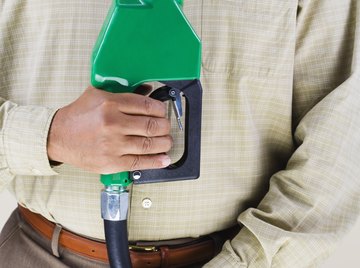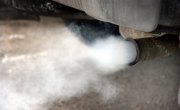
As of 2013, many passenger vehicles can run on gasoline-methanol mixtures containing up to 15 percent alcohol, a blend called gasohol. Its purpose and advantage is that it stretches the supply of gasoline, a fuel refined from non-renewable crude oil, which is partly imported to meet United States demand. The alcohol is locally-made and renewable. Along with the economic benefits come some disadvantages, however, including increased food prices and lowered fuel economy.
Food or Fuel?
The ethanol used in gasohol is made from starchy food crops, such as corn. Farmers must decide whether to sell their corn to a methanol producer or for food; the harvest used for gasohol reduces the supply of food corn, raising its price, and the price of other grains. This is a significant concern because corn has found its way into many foods through high fructose corn syrup and other products. When food corn becomes more expensive, so do many products made from it.
Lower Mileage
Alcohol has a lower energy content than gasoline, so an engine needs to burn slightly more gasohol than it does straight gas to produce the same amount of power, resulting in fewer miles per gallon. On the other hand, gasohol can burn in a leaner fuel and air mixture than gasoline, which offsets the fuel economy problem somewhat. Actual fuel consumption varies from one vehicle to another, as computerized engine systems burn gasohol more efficiently than those with less sophisticated engines.
Engine and Fuel System
Alcohol attacks certain kinds of rubber seals used in car engines and fuel systems. Although modern cars have seals that can handle ethanol, older vehicles may require 100 percent gasoline to avoid fuel leaks and related problems. In addition, gasohol may cause premature wear in two-stroke engines, such as those used in chainsaws and leaf blowers.
Phase Separation
Under certain conditions, gasohol undergoes a phenomenon called phase separation. Over time, methanol absorbs water from the air. At low temperatures, the water sinks to the bottom of the fuel tank, taking the methanol with it and forming a separate layer. When this happens, the car may be burning methanol and water from the tank with little gasoline mixed in, compromising the vehicle’s performance.
References
About the Author
Chicago native John Papiewski has a physics degree and has been writing since 1991. He has contributed to "Foresight Update," a nanotechnology newsletter from the Foresight Institute. He also contributed to the book, "Nanotechnology: Molecular Speculations on Global Abundance." Please, no workplace calls/emails!
Photo Credits
Thinkstock Images/Stockbyte/Getty Images
